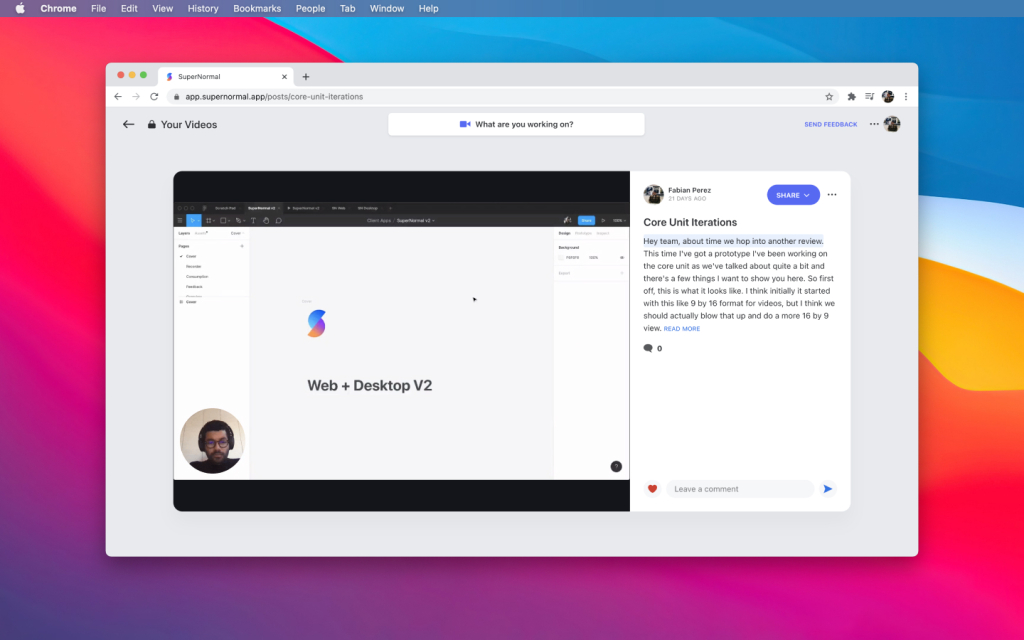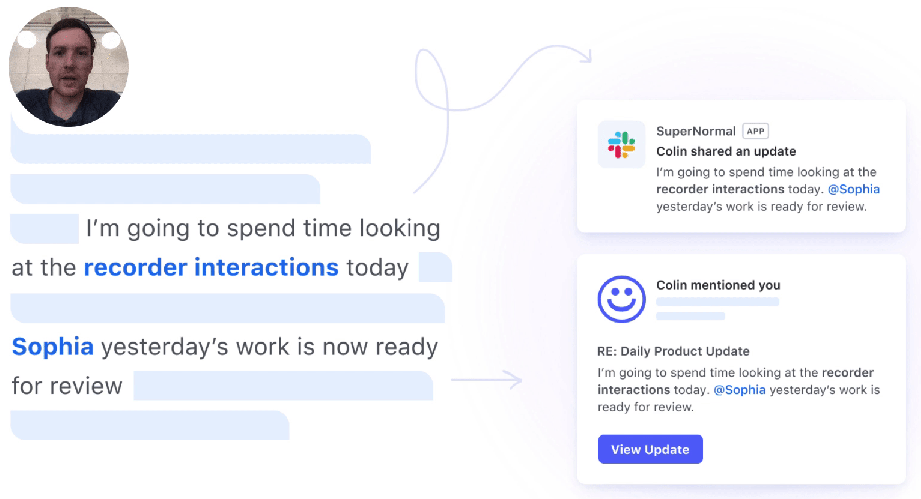Zoom became one of this year’s big success stories for real-time video communications, as the rapid shift to remote work forced businesses to rethink their operations. Now a new startup is setting out to become the go-to platform for asynchronous video communications.
There is no shortage of non-real-time communication tools that allow globally distributed teams to check in with each other — email and Slack, for starters. But Supernormal is meshing video messaging with some nifty AI smarts to bring more engagement and utility to “async” interactions, where nuance and meaning isn’t lost amid a barrage of emojis. At a time when companies are increasingly committing to a distributed workforce spread across multiple time zones, Supernormal could carve itself a niche in a space awash with real-time video and voice tools.
“Supernormal is focused on helping teams communicate async and enabling key personas — engineers, designers, managers — to have creative time and choose when they want to consume or create team communication,” cofounder and CEO Colin Treseler told VentureBeat.
To aid its mission, the company today announced it has raised $2 million in a seed round of funding led by EQT Ventures, with support from several angel investors.
Supernormal (in the new normal)
Available via the web or through a desktop Mac app, Supernormal allows users to record company (or personal) announcements, presentations, greetings, or just about anything else. A separate function lets users record their screen in order to give presentations or product walkthroughs, with a little video avatar of the speaker embedded inside the screencast.
The app uses natural language processing (NLP) to instantly transcribe content and provide it as text beside the video while also extracting what it thinks are the three most interesting sentences from a transcript to suggest as caption summaries.
According to Treseler, the company develops its AI system “mostly” in-house. “We’ve built our own machine learning for detecting the most interesting sentences and have trained it on a massive corpus,” Treseler said.

Above: Supernormal: Screen recording with video message overlay
For businesses that sign up using their Slack or Google account credentials, Supernormal also automatically tags specific users in a company if their name is mentioned in the video, alerting the individual via Slack or Gmail. Presenters are notified whenever their team or intended audience has viewed the video, enabling them to follow up with any relevant communications.

Above: Supernormal: Text extraction and automatic alerts
Videos can also be embedded into digital properties such as websites, and dedicated links can be manually shared through any app. If they’re shared on Twitter, Slack, Facebook, or Microsoft Teams, they can be viewed inline directly on those platforms. Anywhere else, the user will have to click to view the video on the Supernormal platform itself.
The state of play
There are other notable players in the space. San Francisco-based Loom is perhaps the most obvious example, having raised nearly $75 million in funding — including a $29 million tranche in the midst of the pandemic — from notable investors that include Sequoia Capital, Coatue, Kleiner Perkins, and Instagram’s founders. Founded in 2016, Loom has a bit of a head start and an impressive roster of clients, including Atlassian, Intercom, and HubSpot. It also offers additional smarts, such as a drawing tool, allowing presenters to illustrate or highlight specific items on their screen.
Prezi is doing some interesting things in the video presentation realm, though it’s aimed at a different market. Elsewhere, Slack is gearing up to launch a new Stories feature, which are essentially video-based status updates along the lines of Snapchat and Instagram’s consumer versions. Don’t be surprised if Microsoft follows suit with something similar for Teams.
Although it’s still early days for Supernormal, the startup’s use of AI to generate transcriptions, summaries, and smart alerts makes it worth keeping tabs on.
There are also potential use cases far beyond the enterprise, as Loom has demonstrated. For example, teachers struggling to get their entire class online for a live demo could simply record a short video-based presentation and send it by email for the students to view on their own time.
“Right now, we are seeing a lot of use by ‘prosumers,’ and we are open to education/nonprofits,” Treseler said. “Our core focus, however, will be on teams at the enterprise level.”
The story so far
As is increasingly the case with companies these days, Supernormal can’t be pinned to one location, with a workforce spanning the Americas and Europe. Treseler is currently based in Stockholm, Sweden, though he has served in various technical roles on both sides of the Atlantic over the past decade, including a two-year stint as a Facebook product manager in Menlo Park, California.
Treseler and his team started work on Supernormal in January, fortuitous timing given how global events would unfold in the months that followed. “When we started to create our solution, we didn’t expect every business to be relying on virtual communication this heavily,” Treseler said.
Supernormal was initially trying to be more of a catch-all video communication tool, but the company ultimately decided to go all-in on recorded video.
“We had live video in the initial product but felt that it wasn’t additive to the team experience and was not helping our core focus — shifting teams to becoming more asynchronous,” Treseler said.
Since its official launch in August, Supernormal claims it has been picked up by more than 400 teams, with workers at companies like Spotify and GitHub, and has seen “heavy engagement” across the spectrum, from SMBs to Fortune 500 companies.
The company is now working on native apps for Windows desktop and smartphones, along with one-click editing tools that enable users to remove pauses or specific words or sentences from transcripts. Treseler said the team is also exploring additional data reporting and analytics tools for customer-facing roles, such as sales and customer support.
In terms of pricing, it is entirely free for now, as the product is developed and iterated. But Supernormal will eventually adopt a SaaS model, with pricing to be determined. “We’ll eventually get to pricing that is considerably cheaper than the competitors in the space,” Treseler said.
With an extra $2 million in the bank, Treseler said the company will now double down on product development and expand its “fully remote team” around the world.
